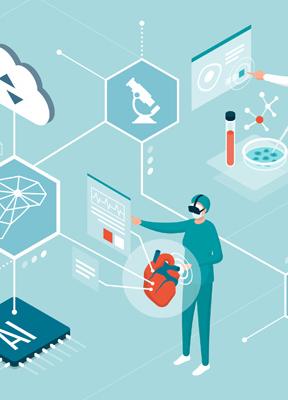“Satisfaction” and “self-confidence” in Medical and Nursing students who had simulated clinical experience: cross-sectional study
DOI:
https://doi.org/10.51723/hrj.v5i23.898Keywords:
Simulation training. Teaching. Emergency medicine. Medicine. Nursing.Abstract
Objective: to assess the constructs of “satisfaction” and “self-confidence” in nursing and medical students who experenced simulated clinical experiences. Methods: a cross-sectional study was conducted in november 2018 with 43 students from the medicine and nursing courses of a Brazilian federal public university. The simulated activity was a multiple-victim incidente involving a collision between a bus and a passenger vehicle. The constructs of “satisfaction” and “self-confidence” were evaluated at the endof the simulated activity using the “Student Satisfaction and Self-Confidence Scale in Lerning”. Data were analyzed using descriptive and inferential statistics in SPSS version 23.0 program. Results: among the participants, the majority were female (27-62.7%), with a mean age of 23.32 years for medicine students and 23.38 years for nursing students. The median for both courses was the eighth semester. There was no difference in the profile of study participants between medicine and nursing students (p>0.05). Overall, the students reported higher levels of “satisfaction” than ‘self-confidence” with the simulated activity, and there was a strong positive correlation between the constructs and the simulated activity. There was no correlation between the students’ course semester and their levels of satisfaction and self-confidence (p>0.05). Conclusions: the simulated activity generated more satisfaction than self-confidence in the students. Higher levels of satisfaction were associated with higher levels of self-confidence in learning.
References
Almeida RGS, Mazzo A, Martins JCA, Baptista RCN, Girão FB, Mendes IAC. Validation to Portuguese of the Scale of Student Satisfaction and Self-Confidence in Learning. Rev Lat Am Enfermagem. 2015;23(6):1007-13. Available from: https://doi.org/10.1590/0104-1169.0472.2643
Costa RRO, Medeiros SM, Martins JCA, Cossi MS, Araújo MS. Percepção de estudantes da graduação em enfermagem sobre a simulação realística. Rev Cuid. 2017;8(3):1799-808. Disponível em: https://doi.org/10.15649/cuidarte.v8i3.425
Meska MHG, Franzon JC, Filho CKC, Pereira Junior GA, Mazzo A. Satisfaction and self-confidence of nursing students in simulateds scenarios with the use of unpleasant odors: randomized clinical trial. Sci Med. 2018;28(1):01-7. Available from: https://doi.org/10.15448/1980-6108.2018.1.28693
Teixeira CRS, Pereira MCA, Kusumota L, Gaioso VP, Mello CL, Carvalho EC. Avaliação dos estudantes de enfermagem sobre a aprendizagem com a simulação clínica. Rev Bras Enferm. 2015;68(2):e311-9. Disponível em: https://doi.org/10.1590/0034-7167.2015680218i
Miranda FBG, Mazzo A, Pereira Junior GA. Use of highfidelity simulation in the preparation of nurses for urgency and emergency care: scoping review. Sci Med. 2018;28(1):01-09. Available from: http://orcid.org/0000-0001-7229-0519
Teixeira INDO, Felix JVC. Simulação como estratégia de ensino em enfermagem: revisão de literatura. Interface – Comunic Saude Educ. 2011;39(15):1173-83. Disponível em: https://doi.org/10.1590/S1414-32832011005000032
Lubbers J, Rossman C. Satisfaction and self-confidence with nursing clinical simulation: novice learners, medium-fidelity and community settings. Nurse Educ Today. 2016;48(1):140-4. Available from: https://doi.org/10.1016/j.nedt.2016.10.010
Hung CC, Liu HC, Lin CC, Lee BO. Development and validation of the simulation-based learning e valuation scale. Nurse Educ Today. 2016;40(1):72-7. Available from: https://doi.org/10.1016/j.nedt.2016.02.016
Boyde M, Cooper E, Putland H, Stanton R, Harding C, Learmont B, Thomas C, Porter J, Thompson A, Nicholls L. Simulation for emergency nurses (SIREN): A quasi-experimental study. Nurse Educ Today. 2018;68(1):100-04. Available from: https://doi.org/10.1016/j.nedt.2018.05.030
Vicente P. O uso de simulação como metodologia de pesquisa em ciências sociais. Cad. EBAPE.BR. 2005;3(1):01-09. Disponível em: https://doi.org/10.1590/S1679-39512005000100008
Ferreira C, Carvalho JM, Carvalho FLQ. Impacto da Metodologia de Simulação realística enquanto tecnologia aplicada a educação nos cursos de saúde. Rev Eletron UNEB. 2017;32-40. Acesso em: 20 jul 2023. Disponível em: https://www.revistas.uneb.br/index.php/staes/article/view/1617
Thomas C, Mraz M. Exploration in tohow simulation caneffect new graduate transition. Clin Simul Nurs. 2017;13(10):465-70. Available from: http://dx.doi.org/10.1016/j.ecns.2017.05.013
Shin S, Park JH, Kim JH. Effectiveness of patient simulation in nursing education: meta-analysis. Nurse Educ Today. 2014;35:176-182. Available from: https://doi.org/10.1016/j.nedt.2014.09.009
Shah A, Mai CL, Shah Ronak, Levine AI. Simulation-Based Education and Team Training. Otolaryngol Clin North Am. 52(6):995-1003. Available from: https://doi.org/10.1016/j.otc.2019.08.002
Downloads
Published
How to Cite
Issue
Section
License
Copyright (c) 2024 SARAH SEMÍRAMIS DO AMARAL ZINATO, CRISTIANE CHAVES DE SOUZA, José Victor Soares da Silva, PATRÍCIA DE OLIVEIRA SALGADO, CRISTIANO VALÉRIO RIBEIRO, FLÁVIA BATISTA BARBOSA DE SÁ

This work is licensed under a Creative Commons Attribution 4.0 International License.
Esta licença permite que outros distribuam, remixem, adaptem e desenvolvam seu trabalho, mesmo comercialmente, desde que atribuam crédito à revista pela criação original.












